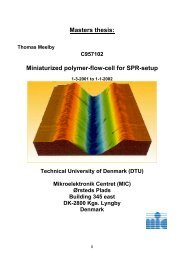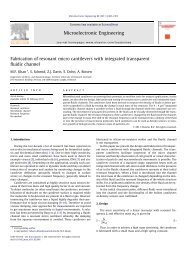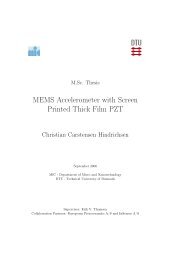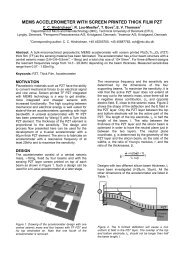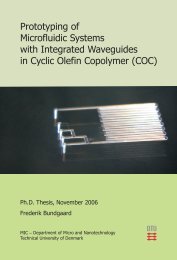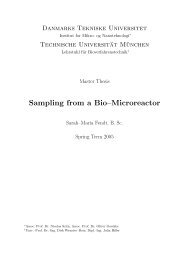Development of a Oxygen Sensor for Marine ... - DTU Nanotech
Development of a Oxygen Sensor for Marine ... - DTU Nanotech
Development of a Oxygen Sensor for Marine ... - DTU Nanotech
You also want an ePaper? Increase the reach of your titles
YUMPU automatically turns print PDFs into web optimized ePapers that Google loves.
50 CHAPTER 6. PROBLEMS AND SOLUTIONS<br />
Figure 6.1: Picture <strong>of</strong> the wirebonder used to attach the wire to the chip and<br />
the flex print.<br />
wiring bonding is not possible to tin. Also people in the industry have suggested<br />
that the Au layer on the chip might have been to thin, and should be<br />
increased to 10k ˚A(it was 3000 ˚A), however others at MIC have successfully<br />
bonded to this thickness be<strong>for</strong>e. However this was only discovered late in the<br />
project, so some other way <strong>of</strong> connecting the chip and the flex print had to<br />
be found at the time.<br />
6.1.1 Conducting Glue<br />
As is <strong>of</strong>ten the case the simplest solution is also the most viable, in this case<br />
a conducting glue. 1 While it may look and sound less refined than a a metal<br />
wire, it is relatively easy to apply with the tip <strong>of</strong> a needle dipped in the glue.<br />
That is if as long as some distance exists between the output electrodes.<br />
The glue used is, like most glues, somewhat viscous and hence if the output<br />
electrodes are to close to each other, it can be very hard if not impossible to<br />
1 The glue is a conductive paste (H9807) from Namics, viscosity: 20 P a ·<br />
s, V olumeresistivity : 0.7 × 10 −4 Ω · cm



